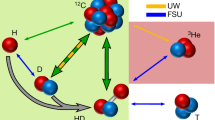Abstract
The traditional compensated Penning trap has been used in the past to precisely measure mass ratios of positrons[1] and protons[2] relative to the electron. Present investigations may allow one to indirectly determine the neutron/proton mass ratio as well as the 3 H — 3 He mass difference to sub-ppb precision. The latter measurement may even have direct impact on the neutrino rest mass experiments[3]. It is also probable that variations of this trap will be used to make precision measurements of the antiproton relative to the proton[4]. Because of the present interest in such mass spectroscopy, a review of the basic method is in order with an emphasis on the use of multiply-charged ions for these measurements with an application to C 4+.
Access this chapter
Tax calculation will be finalised at checkout
Purchases are for personal use only
Preview
Unable to display preview. Download preview PDF.
Similar content being viewed by others
References
P.B. Schwinberg, H.G. Dehmelt, and R.S. Van Dyck, Jr., Phys. Rev. 81A, 119 (1981).
R.S. Van Dyck, Jr., F.L. Moore, D.L. Farnham, and P.B. Schwinberg, Bull. Am. Phys. Soc. 31, 244 (1986).
J.J. Simpson and P. Vogel, in Low Energy Test of Conservation laws in Particle Physics, 1983 AIP Conference Proceedings, No. 114 ( AIP, New York 1984 ) p. 220.
G. Gabrielse, X. Fei, K. Helmerson, S.L. Rolston, R. Tjoelker, T.A. Trainor, H. Kalinowsky, J. Haas, W. Kells, Phys. Rev. Lett. 57, 2504 (1986).
R.S. Van Dyck, Jr., D.J. Wineland, P.A. Ekstrom, and H.G. Dehmelt, Appl. Phys. Letters 28, 446 (1976); also G. Gabrielse, Phys. Rev. A 27, 2277 (1983).
R.S. Van Dyck, Jr., P.B. Schwinberg, and H.G. Dehmelt, Phys. Rev. D 34, 722 (1986), and New Frontiers in High Energy Physics (Plenum, N.Y., 1978 ) p. 159.
L. Brown and G. Gabrielse, Rapid Communications of Phys. Rev. A 25, 2423 (1982).
A.H. Wapstra and G. Audi, Nucl. Phys. A432, 1, (1985).
E.R. Cohen and B.N. Taylor, CODATA Bull. No. 63 ( Pergamon Press, Oxford 1987 ) p. 23.
Author information
Authors and Affiliations
Editor information
Editors and Affiliations
Rights and permissions
Copyright information
© 1989 Springer-Verlag Berlin, Heidelberg
About this paper
Cite this paper
Van Dyck, R.S., Moore, F.L., Farnham, D.L., Schwinberg, P.B. (1989). Mass Ratio Spectroscopy and the Proton’s Atomic Mass. In: De Marchi, A. (eds) Frequency Standards and Metrology. Springer, Berlin, Heidelberg. https://doi.org/10.1007/978-3-642-74501-0_60
Download citation
DOI: https://doi.org/10.1007/978-3-642-74501-0_60
Publisher Name: Springer, Berlin, Heidelberg
Print ISBN: 978-3-642-74503-4
Online ISBN: 978-3-642-74501-0
eBook Packages: Springer Book Archive




